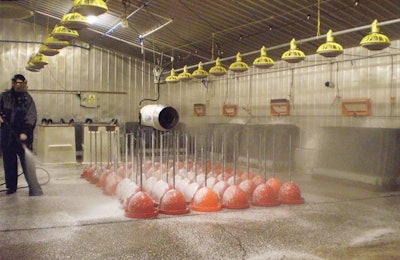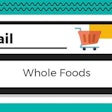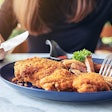
Courtesy Aviagen

Aviagen's guide on biosecurity best practices includes 10 steps that should be taken to clean and disinfect a poultry house.
Those 10 steps are:
- Create a plan: A poultry house cleaning and disinfection program should have a plan, detailing dates, times, labor and equipment needed. This should be established prior to depleting the farm.
- Control insects: Wearing appropriate protective equipment, spray the poultry house interior with a locally recommended insecticide as soon as the flock is removed and while the house is still warm. A second treatment with insecticide should be completed before fumigation.
- Remove dust: Remove all dust and cobwebs from interior surfaces and equipment.
- Pre-spray: Wearing appropriate protective equipment, spray detergent solution throughout the broiler house interior to dampen any remaining dust. Close the curtains in open-sided poultry houses first.
- Remove equipment: Remove all equipment from the house and raise automatic feeders and drinkers.
- Remove and dispose of litter: Litter must be removed to a distance of at least 2 miles and disposed of in accordance with government regulations.
- Wash and rinse: Use a pressure washer with a foam detergent. Ensure the detergent is compatible with the disinfectant to be used. Rinse with hot water.
- Clean water and feeding systems: Water pipes should be cleaned at least once per flock to remove any biofilm that may have built up. If physical cleaning is not possible, use high levels (140 ppm) of chlorine. Empty bulk bins and connecting pipes and brush out. Clean out and seal all openings.
- Disinfect: Use an approved disinfectant that is effective against specific poultry bacteria and viruses. Follow manufacturer’s instructions at all times.
- Fumigate: Fumigate as soon as possible after disinfection; surfaces should be damp and the house warmed to a minimum of 70F and a relative humidity of greater than 65 percent. Seal the house for 24 hours.
The guide stresses that site cleaning must remove all potential poultry and human pathogens and minimize the number of residual bacteria, viruses, parasites and insects between flocks.
Potential routes of disease exposure include feed, housing, wild birds, litter, rodents, equipment and vehicles, insects and people.
Aviagen says a good biosecurity plan must be:
- Robust
- Mandatory
- Practical
- Cost effective
- Part of the staff training program
- Financially resourced
- Reviewed regularly













